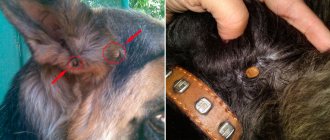What is the danger
Are ticks dangerous for cats or do they only bite dogs?
Many people doubt whether ticks bite cats and believe that this type of parasite does not affect them. It is a myth. Representatives of Ixodidae bite everyone. It’s just that dogs constantly visit the street and parasitic diseases are recorded more often in them.
The Ixodid tick is a small spider with a disk-shaped body, a small head and 8 legs (see photo).
Color – all shades of brown. Females drink more blood. If the parasite is hungry, its body is approximately 2-4 mm in size. But the gluttony is surprising. The body weight of females increases 80-120 times during feeding. When she drinks blood, she is able to swell into a ball up to 1.5 cm, and the color changes from brown to dirty gray.
The danger for cats lies in the ability of ixodids to be carriers of various serious diseases. The culprits of diseases are protozoan parasites and viruses that live in the body of an ectoparasite.
The consequences of a bite are manifested by such infectious diseases as:
- hemabartonellosis;
- borreliosis;
- theileriosis;
- piroplasmosis;
- babesiosis
Any parasitic disease does not develop immediately after a bite. Time must pass - on average 2-3 days, sometimes more.
How difficult the disease will be depends on a number of factors:
- the general well-being of the animal and the state of immunity;
- age;
- number of bitten bloodsuckers;
- timeliness of measures taken by the owner.
Pregnant cats and kittens are especially at risk. If an infection or virus enters the body of a pregnant animal, then the offspring will also be affected.
Vet
If you can’t remove a tick from a cat yourself at home, and the owner himself needs medical help, there is only one way out: a visit to specialists. How much it costs depends on the region and level of the clinic. In Moscow you can get a tick for 150 rubles, in Dzerzhinsk for 50 rubles.
At the veterinary clinic, the cat will be immobilized in a “sleeve” and the parasite will be pulled out, using industrial tools to extract the arachnids. At the owner's request, the parasite can be analyzed for the presence of infectious diseases. If the ixodus has been infected, it is better to start treating the cat as early as possible.
The principle of action of the tick
It takes the female parasite up to 4 hours to find a suitable place on the cat’s body. That’s why it’s so important to examine the cat immediately after a walk, before the “guest” has time to latch on.
After the location is found, the tick bites the cat’s skin and injects an anesthetic secretion. And only after about a day does it begin to feed on blood. Therefore, the owner has 24 hours to remove the tick from the cat.
Under the influence of incoming warm blood, intracellular parasites are activated in the tick's intestines, begin moving through the bloodstream and end up in the saliva.
The female swells up from drinking blood, increases significantly in size and splashes out excess liquid in the form of saliva. Pathogens enter the animal’s blood through the wound.
If a tick is found already filled with blood, and it turns out to be a carrier, then the cat is infected. In such a situation, it does not play a big role when to remove the tick from the cat’s body. But the fact is that 10 individuals can sit on a cat and all of them will turn out to be harmless, or maybe one will be a carrier of a serious disease. In any case, if a cat is bitten, you cannot immediately begin treatment; perhaps the parasite is not contagious, and all medications have side effects.
Common Mistakes
When removing ticks from cats, many people make serious mistakes. For example, they remove the parasite with their fingers or pour it with oil. If there is no device at hand that makes it easy to remove the tick, some cat owners try to do it with their hands. This is not the best idea - if you grab the body from both sides, you can easily crush the parasite. Then its contents will get into the wound. If the tick is infected, the cat will get sick.
Another mistake is to pour oil on it before removing a tick from a cat. Many people think that then the parasite will have nothing to breathe. The tick will actually suffocate under the oily film.
However, before he dies, he will regurgitate the contents of his intestines, which will end up in the wound. In this case, the risk of infection will increase several times. For this reason, you cannot use other oil-containing substances (gasoline, kerosene) to pull out the arachnid.
Signs of a bite
A tick on a cat may not be immediately noticed by the owner or may not be noticed at all. The female drinks blood for 5-7 days, then she falls off the body to lay eggs in a secluded place. Therefore, if a small bloodsucker is found on a cat and she has symptoms of malaise, this does not mean that it is the cause. Most likely the culprit is another specimen that has already fallen off the body.
You should be wary if your pet exhibits the following signs:
- lethargy;
- depressed state;
- loss of interest in the game;
- lack of appetite;
- elevated temperature – in cats it is over 39 degrees;
- dark colored urine;
- shortness of breath, cough;
- unsteady gait;
- yellowing of the eyes.
If a cat is bitten by a tick, symptoms of the disease appear between 3 days and 3 weeks after the bite. It is not necessary that all signs will appear, there may only be one. The owner needs to monitor the pet and measure the temperature up to 5 times a day. If there is a deviation from the norm, immediately contact a veterinary clinic. The success of treatment depends on early detection of the disease, correctly selected medications and the cat’s immunity.
Fact: Female ticks are among the most fertile. During their life they lay up to 20 thousand eggs.
How to remove ticks from a cat at home
How to remove a tick from a cat? If a tick has jumped on your cat, the best option is to take her to the vet. If this is not possible, then you can get the tick yourself at home.
It has already been said above, and we will repeat it again: you cannot treat the bite site with anything. No oil, wax or kerosene! This will only make the situation worse. You cannot pick at the tick; you need to remove it entirely at once without separating the body from the head.
First put on rubber gloves; this precaution will not be superfluous. Which tool is suitable? It is important not to use any needles or other sharp objects. The most convenient way to remove it is with a special hook with a forked end, which is sold in pharmacies. You can also use thread or tweezers.
The tick must be hooked on both sides so that it holds tightly. You need to cling it as close to the skin as possible, but do not try to pick at the wound to grab the head, it will be very painful for the cat and the tick will begin to move. If you remove a tick using a thread, you need to be extremely careful. In this case, it is very easy to tear off your head. When you grab a tick, you need to take it out immediately. But you need to do this by carefully rotating it clockwise. Try not to disturb him again so that he does not secrete saliva. Once a tick is caught, you cannot simply throw it away.
Killing them is quite difficult: they do not drown, and you cannot crush them either. Moreover, they can attach themselves a second time.
In this case, regular alcohol will help. Just drown in it. But it’s even better to take the tick to the laboratory. There they will conduct tests for the presence of infection. And if the parasite has been infected, you can start treating your pet much faster, which can save his life.
Treatment of the affected area
You cannot lubricate the wound before catching the tick. But after that it’s very necessary. You can treat the wound with hydrogen peroxide or chlorhexidine. It is not worth treating the wound with brilliant green or iodine. This is both painful and the cat may then begin to lick them off. After removing the tick, observe the animal for 2-3 weeks.
Signs of a bite are not always clearly expressed. Any deviation from the norm of behavior should alert you and in this case it is better to immediately consult a doctor.
If the infection does begin, immunoglobulin injections are prescribed. In severe cases, IVs are given. The animal can also paralyze. The sooner you contact a specialist, the lower the risk and the better the treatment prognosis.
Anti-tick products for cats
Many owners are more concerned about flea protection. But ticks are no less dangerous, just more rare. If you live near a forest or field, then the chance of being bitten is much higher. Therefore, if you do not want the animal to suffer, it is better to take preventive measures for protection.
What can help? Collar. Convenient option, non-toxic. The substance that repels parasites gets onto the fur, driving them away. Suitable for cats that are constantly walking. But it also has its downsides. It can rub and cause an allergic reaction. If the cat does reach it, then the risk of poisoning cannot be ruled out. The collar can get caught on branches, so try to keep it snug, but not too tight.
Another option is drops on the withers. The cat won't be able to reach there. This option is the most effective. You need to drip monthly. But these products are toxic and if the cat somehow gets it, poisoning will definitely occur.
Sprays are also suitable. They are used if the cat does not go outside often, as they have a short lifespan. But they are safe. The entire body of the cat should be covered with spray and wait until it dries completely. Therefore, the cat must be under constant supervision.
Despite all precautions, they are not a 100% guarantee. Especially if the instructions for use are violated. Ticks will also attack the cat, they just won’t have time to bite it. But they may make it in time. Therefore, despite all precautions, a simple inspection will not hurt.
Ticks are terrible not only for animals, but also for people. If he latches onto your pet, this does not mean that he will not attack you. Therefore, it is better to wear rubber gloves and carry out the inspection not on the sofa, but on the floor to notice the crawling parasite. Don’t forget to destroy them correctly—alcohol is the best thing, but you shouldn’t wash them off.
Bite sites
Is it true that ticks love to live on oak trees and fall onto walking cats from tree branches?
It is wrong to think so. Ixodid ticks do not climb to a height of more than one and a half meters. The main habitat is grass, including dry grass and shrubs.
Even a completely domestic cat becomes a victim of the parasite if the owner brought it into the house on his clothes. An ectoparasite can hide for several days or even weeks and then bite a cat.
Fact: Ixodids tolerate drought, lack of food, and sharp drops in temperature because they can slow down their development at any stage. An adult can easily go without food for up to 2 years.
Parasites, having landed on an animal’s body, look for a place where the skin is thinner so that it is easier to bite through and where the animal cannot shake it off with its paw or reach with its tongue. The main weapon of a tick is a proboscis with jaws and tentacles. With its jaws it cuts the skin of the animal and attaches itself with them.
The most popular places are:
- withers;
- stomach;
- groin;
- armpit area;
- behind the ears.
On short hair, parasites are clearly visible, but long-haired cats need to be combed with a comb against the direction of hair growth. If a cat has been bitten by a tick, stroking it with the palm against the fur will help find it. A lump will be revealed to the touch.
How to protect your pet from ticks
No matter how hard you try and what products you use, you will not be able to get 100% protection from dangerous insects for your cat. But it is in your power to minimize the risk of the parasite getting on your cat. After all, when returning home from a walk, your pet will bring a tick into the living room. In this case, one of the family members may suffer. Therefore, it is worth using special insect repellents.
There are several varieties of them. You can choose the product that is most convenient for your animal.
Collars
This is a simple and inexpensive means of prevention, which is very popular among pet owners. The collar consists of a strip that is impregnated with a special tick-repellent composition. Does not pose any danger to an adult and healthy cat.
Positive sides:
- The effect of the composition with which the collar is impregnated is quite long-lasting. From three to five months. This allows you to protect the animal for a long time;
- It is not difficult to use - just put the collar on the animal and fasten it so that it does not put pressure on the cat’s neck, but also does not come off over the head;
- Another positive quality, of course, is the low cost of this prophylactic agent.
Negative sides:
- Under certain conditions, the collar can cause allergic reactions or local irritation, which may cause baldness on the animal’s neck;
- Due to the high toxicity of the collar impregnation composition, its use on pregnant women and cats with health problems is prohibited. Not recommended for small kittens;
- If an animal chews or licks the collar, it can get quite severe poisoning due to the toxicity of the composition used for impregnation.
Sprays
Today, these are the most effective means of protecting animals from ticks. The main and rather big disadvantage of this drug is its inconvenience to use:
- The product should be applied to the entire coat of the animal, distributing it evenly throughout the body. Carefully ensure that the caustic composition does not come into contact with the animal’s genitals, eyes, nose or mouth;
- While spraying the composition, the animal should not move to avoid the spray getting into dangerous places. This condition is quite difficult to fulfill;
- After applying a protective spray to the cat’s fur, you must wait for it to dry completely, keeping your pet from licking the fur, which can lead to severe poisoning;
- Possible signs of poisoning by the composition of the protective spray are: excessive salivation and vomiting.
Experts call Frontline as the safest product among protective sprays, but its cost is quite high.
Drops
The drops must be applied to the animal’s body between the shoulder blades, since in this place it will be inconvenient for the cat to lick itself, which means the drops will not get inside the animal. Once on the skin, the drops are absorbed and begin to work - they repel and sometimes even kill the attached ticks.
- It is permissible to use repellent drops even on kittens starting from eight months, as well as on pregnant cats;
- Preparations containing pesticides cannot be used on sick animals, small kittens and pregnant cats;
- It is not recommended to use this remedy more than once a month.
In any case, before using this or that product, you should carefully read the attached instructions. If after using the drug the animal experiences intoxication, then it is necessary to show the cat to a veterinarian.
How not to pull it out
Seeing a small spider on a pet, many owners panic and often make mistakes:
- They fulfill their first desire - to rip off the parasite
There should be no sudden movements or jerks. They pull it out with twisting movements in one direction so that the spines on the proboscis do not puff up, but press against it. This is the only way to remove the parasite along with the head.
- Lubricated with oil
Vaseline, vegetable oil, and machine oil are used to cut off oxygen to the parasite. The effect will be that the tick will not like this method, and it will begin to move backwards, perhaps even falling off the cat’s body. However, while this happens, he will have time to inject infected saliva. The moment has passed.
- They're putting pressure
By crushing a tick with your fingers, the cat owner increases the risk of infected blood getting into the wound.
How to find a parasite
After each walk, it is advisable to inspect the animal for the presence of ticks. It looks like a flat brown drop, ranging in size from two to five millimeters. After the parasite drinks blood, its size can increase to one and a half centimeters, and it itself becomes like a gray wart. If you look closely, you can see the hooked legs and the point of the head.
The sooner the parasite is detected, the better. Once on the skin, it does not immediately dig into it, but within two hours it can look for a suitable place to bite. Therefore, examining your cat immediately after coming home can give you a chance to find the tick before it burrows into the skin.
- Most often, parasites burrow into the skin of the armpits, thighs, abdomen and behind the ears. In cats, they prefer the groin area.
- Having found a suitable place, the tick cuts the tissue and pushes its proboscis as deep as possible.
- With the help of an oral apparatus with teeth and hooks, the parasite is securely fixed in one position and begins to alternately suck out blood and lymph.
- While feeding, the tick injects special enzymes into the wound that relieve pain. Due to this, the animal does not show any anxiety, since it simply does not feel the presence of the parasite.
Interesting: Blood in a cat’s stool: causes and possible treatments
Therefore, in order to detect a tick on a cat, it should be carefully examined, felt or combed against the grain.
Caring for your cat after tick removal
When the process of removing a tick at home has been successful, you need to carry out a number of control measures:
- If the wound is clean, treat it with any antiseptic: iodine, hydrogen peroxide, alcohol, brilliant green.
- If the head remains in the wound, it must be carefully removed with tweezers and the bite site disinfected. It is better not to use a needle, there is a risk of picking more of the wound. If you leave the head, there may be a complication in the form of inflammation, like with a splinter.
It is not always possible to free the bite site from the remains of the tick. In this case, the hair is clipped and the wound is lubricated with chlorhexidine (0.05%) twice a day to prevent inflammation. Over time, the cat’s body itself will reject the foreign body. The head will come out with pus. The second option is that it will become overgrown with connective tissue and a compaction will form under the skin. If swelling and redness appear, you should consult a doctor, as there may be an abscess that needs to be opened. However, this does not happen often.
Can a tick hide under the skin?
Ixodids do not live under the skin. They can sit on a cat for a month, but will not completely move under the skin.
The vector tick and the regular tick do not differ in appearance. Moreover, if the owner reacted quickly, then it is not a fact that the carrier managed to infect the cat. There is no point in immediately taking the cat to the veterinary clinic to donate blood for analysis. Protozoa appear in the animal’s blood only after 3-4 days. If you donate blood on the first day of the bite, the result, even if it is negative, is considered false.
The analysis is carried out twice with an interval of 5-7 days.
Symptoms of a tick bite in a cat
Ticks can only be detected on a cat's body through regular inspections. But even if you didn’t find anything, it’s not a fact that the pet wasn’t bitten. Symptoms after a bite may not appear immediately, but after 2-3 weeks. Therefore, carefully monitor your cat’s behavior and well-being. Especially after a bite. It’s even better to immediately contact a veterinarian; in this case, you can’t hesitate.
Each body reacts differently. But there are common symptoms. And if, after you find a tick, at least one of them appears, immediately consult a doctor. What are the symptoms: increased body temperature, refusal to eat, noticeable weight loss, apathy and lethargy, diarrhea and vomiting, strange shade of urine (pink or green), irritation or decay at the site of the bite.
Prevention of bites
Cats that live and walk near the forest (for example, in the country) are at risk. To protect them, there are numerous antiparasitic agents sold in veterinary pharmacies. They are designed to repel insects and ticks. Here are the suitable options:
- Sprays and drops on the withers. The most effective, but are toxic and act for a short period of time. Animals should not be allowed to lick them from their fur.
- Collars. Thin rubber straps are impregnated with a special compound. Less toxic, but due to prolonged contact with skin, allergic reactions or irritation may occur. It is better to wear them only when walking and take them off at home.
Any owner wants his pet to be healthy. This means that in the warm season you need to pay increased attention to the cat’s safety and use preventative agents against ticks.











